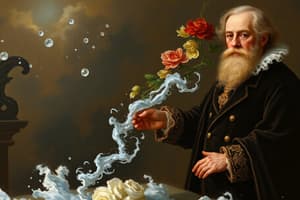Podcast
Questions and Answers
What is the definition of gas pressure?
What is the definition of gas pressure?
- The volume of gas in a fixed container
- The temperature of a gas divided by its volume
- Force exerted per unit area (correct)
- The mass of a gas per unit volume
Which unit is NOT commonly used to measure gas pressure?
Which unit is NOT commonly used to measure gas pressure?
- Atmosphere
- Millimeters of mercury
- Pascal
- Bar (correct)
What happens to the pressure of a gas in a fixed-volume container after a complete reaction that produces no additional gas?
What happens to the pressure of a gas in a fixed-volume container after a complete reaction that produces no additional gas?
- Pressure remains the same
- Pressure increases
- Pressure fluctuates intermittently
- Pressure decreases (correct)
According to Boyle’s Law, how are pressure and volume related?
According to Boyle’s Law, how are pressure and volume related?
Which of the following best describes Charles’s Law?
Which of the following best describes Charles’s Law?
What is the standard temperature and pressure (STP) for gases?
What is the standard temperature and pressure (STP) for gases?
What must be true for gas law problems to be calculated accurately?
What must be true for gas law problems to be calculated accurately?
What principle explains the behavior of gases based on molecular motion?
What principle explains the behavior of gases based on molecular motion?
What law can be used to calculate the moles of gas in a chemical reaction involving gaseous reactants?
What law can be used to calculate the moles of gas in a chemical reaction involving gaseous reactants?
Which of the following describes the main focus of the kinetic molecular theory?
Which of the following describes the main focus of the kinetic molecular theory?
What determines the most probable speed of gas particles?
What determines the most probable speed of gas particles?
What does the root mean square speed (vrms) measure in a gas sample?
What does the root mean square speed (vrms) measure in a gas sample?
How do gas molecules behave regarding distance and collisions according to kinetic molecular theory?
How do gas molecules behave regarding distance and collisions according to kinetic molecular theory?
What does Avogadro's law state about the volume of a gas?
What does Avogadro's law state about the volume of a gas?
What is the purpose of the combined gas law?
What is the purpose of the combined gas law?
What is Dalton's law of partial pressures regarding a mixture of gases?
What is Dalton's law of partial pressures regarding a mixture of gases?
In the ideal gas law equation, what does the variable R represent?
In the ideal gas law equation, what does the variable R represent?
If the pressure of a gas increases while keeping the temperature constant, what will happen to its volume?
If the pressure of a gas increases while keeping the temperature constant, what will happen to its volume?
What happens to the volume of a gas when its temperature is raised at constant pressure?
What happens to the volume of a gas when its temperature is raised at constant pressure?
Under what conditions can the ideal gas law be applied effectively?
Under what conditions can the ideal gas law be applied effectively?
Given a mixture of gases, how can the partial pressure of an individual gas be determined?
Given a mixture of gases, how can the partial pressure of an individual gas be determined?
Flashcards are hidden until you start studying
Study Notes
Gas Pressure
- Gases do not have definite volumes and expand to fill the entire volume of its container
- Pressure is force exerted per unit area
- Several units are used to measure pressure like atmospheres (atm), mm Hg, Pascal (Pa), and kilopascal (kPa)
- Standard temperature and pressure (STP) is a specific set of temperature and pressure conditions for a gas
Boyle's Law
- Pressure and volume of a gas are inversely proportional at constant temperature
Charles's Law
- The volume of a gas is proportional to its absolute temperature at constant pressure
- Gas laws problems must ALWAYS be worked in Kelvin
The Combined Gas Law
- This relationship is derived from a combination of other gas laws to demonstrate the relationship between the pressure, volume, and temperature of a sample of gas.
Avogadro's Law
- The volume of a gas is proportional to the number of molecules or moles of the gas present at fixed pressure and temperature
Ideal Gas Law
- Ideal gas law describes the relationship between the pressure, volume, temperature, and number of moles of an ideal gas
- R has several possible sets of units. It is easiest to always use the same value for gas laws and make sure the units of P, V, n, and T all match.
- The formula of Ideal gas law: PV=nRTPV = nRTPV=nRT
Dalton’s Law of Partial Pressures
- The pressure of a mixture of gases is the sum of the partial pressures of the component gases in a mixture
- Partial pressures can be calculated based on the mole fraction of the gas.
Gases in Chemical Reactions
- Stoichiometry always is about moles
- Use the ideal gas law to determine moles of gas present
Kinetic Molecular Theory of Gases
- Kinetic-molecular theory provides connections between the observed macroscopic properties of gases, the gas law equation, and the behavior of gas molecules on a microscopic scale
- Five postulates of the kinetic molecular theory:
- Gases consist of particles in constant, random motion.
- The volume of the particles is negligible compared to the volume of the gas.
- There are no attractive or repulsive forces between the gas particles.
- Collisions between gas particles and between gas particles and the container walls are perfectly elastic. The energy lost by the particles during a collision is negligible
- The average kinetic energy of the particles is proportional to the absolute temperature in Kelvin.
- Higher temperature and lower molar mass result in higher speed
Movement of Gas Particles
- The root mean square speed, vrms, is the velocity of a particles possessing the average KE in a gas sample of known molar mass.
Studying That Suits You
Use AI to generate personalized quizzes and flashcards to suit your learning preferences.




